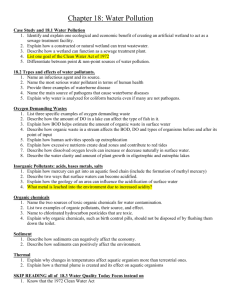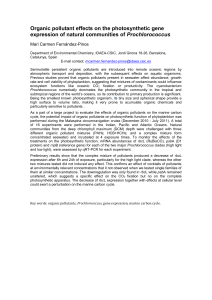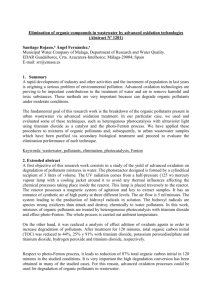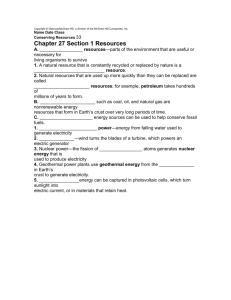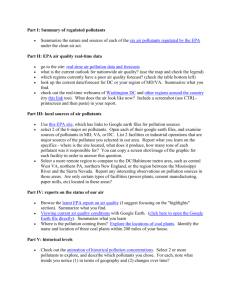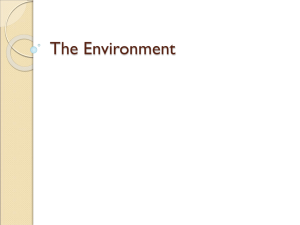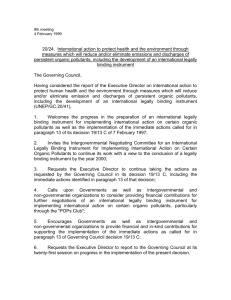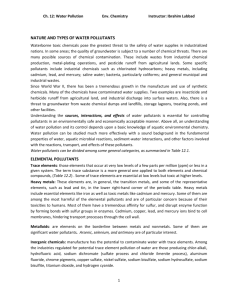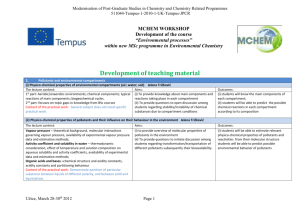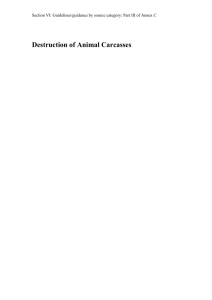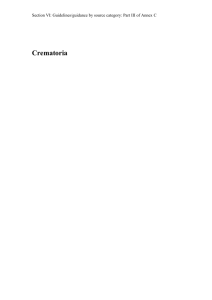Questions for self
advertisement
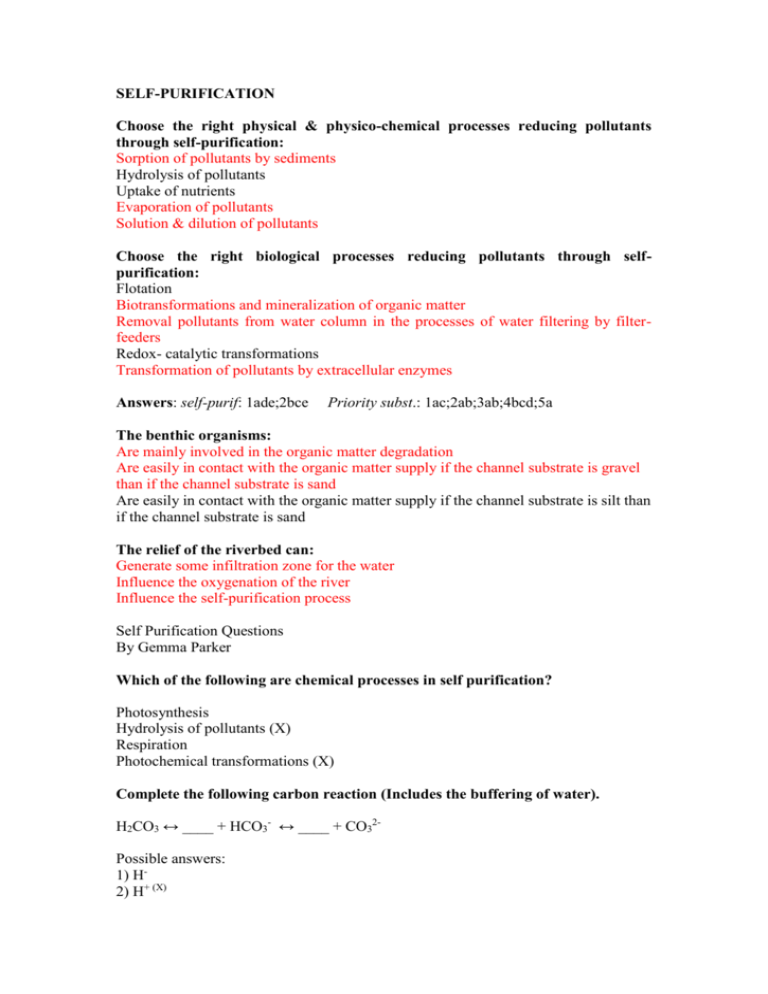
SELF-PURIFICATION Choose the right physical & physico-chemical processes reducing pollutants through self-purification: Sorption of pollutants by sediments Hydrolysis of pollutants Uptake of nutrients Evaporation of pollutants Solution & dilution of pollutants Choose the right biological processes reducing pollutants through selfpurification: Flotation Biotransformations and mineralization of organic matter Removal pollutants from water column in the processes of water filtering by filterfeeders Redox- catalytic transformations Transformation of pollutants by extracellular enzymes Answers: self-purif: 1ade;2bce Priority subst.: 1ac;2ab;3ab;4bcd;5a The benthic organisms: Are mainly involved in the organic matter degradation Are easily in contact with the organic matter supply if the channel substrate is gravel than if the channel substrate is sand Are easily in contact with the organic matter supply if the channel substrate is silt than if the channel substrate is sand The relief of the riverbed can: Generate some infiltration zone for the water Influence the oxygenation of the river Influence the self-purification process Self Purification Questions By Gemma Parker Which of the following are chemical processes in self purification? Photosynthesis Hydrolysis of pollutants (X) Respiration Photochemical transformations (X) Complete the following carbon reaction (Includes the buffering of water). H2CO3 ↔ ____ + HCO3- ↔ ____ + CO32Possible answers: 1) H2) H+ (X) 3) H 2+ 4) H 2Complete this anaerobic decomposition reaction in sediments, by filling in the correct answers. Complex carbohydrates, 3, lipids → 2 → amino acids, simple sugars and fatty acids → 1 → fatty acids, alcohol, CO2 and H2 → terminal e- accepting stage → 4, sulfate reduction and methanogenesis → CO2CH4 1) Fermentation 2) Hydrolysis 3) Proteins 4) Denitrification Monitoring By G.Parker RHS Reference Sites in England and Wales are carried out in which months? Jan-Feb April-May May-June (X) June-July RHS is carried out preferably during which type of flow? High Optimum Flood Low (X) What is the main difference between Belgium biological index and Trent biotic index? Greater number of indicator taxa (X) Has no calculations Larger overall biodiversity More dependant on pollutant species What do BBI (Belgium biological index) and TBI (Trent biotic index) have in common? Same indicator species Indicator species ranked in order of increasing tolerance to pollution (X) Indicator species ranked in order of decreasing tolerance to pollution No similarities BBI is split into 5 classes. Which one is for unpolluted waters? 1-2 0 9-10 (X) 1 Which one of the following is not commonly used biological indicator in the EU? Fish (X) Plants (X) Algae (X) Benthic Invertebrates The classifications of river sites is based on? Chemical parameters Families and abundance (X) Presence and absence of species (X) Families as in the BMWP score (X) How are invertebrates collected in river samples? 5 min kick sample (X) Collection rocks and stones Sweeping net in water (X) 1 min kick sample (X) The sweeping method is used for? To observe the animals Water quality (X) Finding chemical status Rapid pin pointing of sources of pollution (X) Questions for self-purification Fe, Mn, Zn, Cu, Co are… Essential micronutrients. Metals. Enzymes. Proteins. Sulfur is… Reduced to sulfat in oxic water, by reducing bacteria. Oxidised to hydrogen sulfid in anoxic water, by oxidising bacteria. Non of both above. 1. A stream receiving an excessive amount of organic waste exhibits changes, which can be differentiated and classified into zones. Mark the right order. a, clean zone, septic zone, zone of recent pollution, recovery zone, clean zone b, clean zone, zone of recent pollution, septic zone, recovery zone, clean zone c, clean zone, zone of recent pollution, recovery zone, septic zone, clean zone 2. Saprobity a, … is the amount of organic matter and the activity by microbial communities living on it. b, … is a term introduced in the UK for the assessment of water quality. c, … can be calculated by a biotic index of organic pollution. 3. The organic matter degradation involves several processes: a, shredding of the organic matter by various invertebrate and vertebrate taxa b, decomposition of the small particles to mineral matter by hypomycetes and bacteria c, chemical degradation by abiotic oxidation or photooxidation Answers about Self-purification Which parameters influence self-purification? Oxygen Flow Temperature pH Geomorphology of riverbed Substrate structure Link filtering process to the right sentence: biochemical filtering precipitation of organic matter mechanical filtering degradation by fauna chemical filtration organic matter stopped by the interstices of the sediment A large increase in phosphorus in the water causes? The water to turn white There is no change in the environment Fish become increasingly abundant Rapid algae growth Pollution affect on river organism’s communities are? (More than one answer) Very little affect Reduce species diversity Reduce of biomass and cover Fish become more prolific Sensitive organisms disappear from rivers because They are very shy To much noise from the neighbors Excessive organic waste pollutes the water Vegetation is incorrect.
